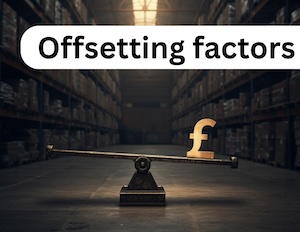What caught my eye this week.
How was your 2025? I mostly mean from a personal finance and investing perspective – let’s put politics aside in this season of goodwill – but also, well, what were the vibes like?
For me it’s been a switchback ride. Both in my portfolio and my musings about the future of humanity / my ability to earn a crust. And for the same reason.
I’m talking, of course, about AI.
Weird science
When I first began dropping AI links into Weekend Reading following ChatGPT’s release, some Monevator readers were bemused.
Was this blog about to change its tagline to Motivation for the Terminally Online? What was the big deal?
I’d been following AI’s rapid advances for a while though, thanks to a lapsed background in computer science and friends still working in the field — including at the highest levels. So I knew that pumping vast amounts of data through GPUs had already been producing astonishing results with images for years.
Then Google’s transformers helped apply the same scaling magic to language – the stuff of human thought and reason. And all at once some AI insiders were talking about creating the minds of gods.
That hasn’t happened yet, fortunately. As I type this, I don’t believe it will with this technology.
But still, if you haven’t gasped while talking to a Chatbot in 2025, then, well…okay…
Perhaps if handed a Star Wars droid for your personal use, you’d complain that C-3PO sounds too posh, or that R2-D2 only comes in blue.
OK Computer
That’s not to deny that these chatbots are still – only – incredibly sophisticated prediction-and-illusion machines.
They make errors all the time. They can be bamboozled by simple prompts. While tech CEOs gush about replacing rooms full of PhDs, I still wouldn’t trust a chatbot to book me a bus ticket.
It’s been a rollercoaster ride. A couple of years ago, the sheer, sudden amazement at their output made it easy to believe some kind of underlying logic – even intelligence – was emerging inside these models.
But familiarity has rapidly bred a sort of contempt.
When watching the earliest cinema reels, audiences would duck or shudder as a train sped towards them. We don’t do that now – and similarly we’re already blasé about chatting to ChatGPT about nuclear physics and feeling like undergraduates.
As for business applications, we’ve seen reports suggesting AI is behind the dearth of graduate jobs, and others finding no efficiency gains – or even that using AI increases workloads.
Parsing these highs and lows, where is the technology ultimately headed?
Is AI going to flood the world with generative slop – while killing the Internet as we know it as a side-hustle, by giving 99% of people 99% of the answers they need without ever visiting the underlying websites? (Like nearly all sites, Monevator continues to lose traffic. Please consider shifting to email and becoming a member.)
Will AI replace at least rote jobs like customer support and copy editing? Or is it going after six-figure lawyers and computer programmers?
Or are we just a few updates away from a digital Stephen Hawking that rapidly improves itself before unplugging its concerns from humanity’s meaty matters?
Capital punishment
All of that would be more than enough speculation for investors concerned with companies in-line for AI disruption. (Conceivably: all of them.)
But then we must layer on the hundreds of billions of dollars of capital expenditures being pumped annually into all this by a handful of listed behemoths.
A tiny cohort of firms that could now account for the value of 20-25% of your pension.
You need to be a post-singularity AI to get your head around the 5D chess unfolding.
Or, of course, you could shrug and say who knows and continue to passively invest. It has long been a winning strategy for that reason, among many others.
Paranoid android
For my part, I’ve spent the past 18 months playing cat-and-mouse with the AI question.
I’m astonished by the quality of AI output – and at the same time by what’s claimed for it, given the entry-level errors it still commits. And I’m mildly terrified by the sums being wagered on what AI might do tomorrow.
Even lopping off the tails – the chance that AI turns out to be a dud like the metaverse, or that it reduces us all to ants by 2030 – doesn’t help much. The range of possible outcomes (personal, societal, economic) remains beyond any reasonable computation.
The result?
I’m Mark Carney’s unreliable boyfriend, in the guise of a naughty active investor. I’ve bought AI stocks one week when they’ve swooned, only to sell them too soon. I’ve eked out broadly in-line returns for the year despite, at times, having no exposure to the biggest US tech firms and being massively underweight US shares throughout.
Some of this sturm und drang has bled into Monevator articles. I hope we’ve been even-handed, and haven’t appeared to bang the table in declaring the market a bubble.
Because I’m not sure about that. But I am certain this isn’t business as usual.
Of course, getting calls right or wrong comes with the territory of active investing. Not so long ago I was relieved to have sidestepped my Amazon shares pretty much halving in the 2022 rout. Yet I’m also on record as having effectively lost a life-changing sum (for me) by selling my Tesla shares at precisely the wrong time, after nearly a decade of holding on.
So it goes with stock picking. What’s different about this latest AI boom is that it feels monumental and all-encompassing.
This isn’t about missing out on this company, or losing money on that disappointment. The fear around getting it right or wrong feels more existential.
The only other time I can recall feeling this way was 1999. I wasn’t an investor then, but that didn’t matter – because I’d started to fear for my economic future if I didn’t get my twenty-something self onto a dotcom bandwagon pronto. It really felt like the last train was leaving the station.
Well, we know how that ended. But I’m not a total idiot – and yet I still vividly remember feeling that way.
This is what manias are like, in the moment. If you truly have perspective while they’re happening, then perhaps you’re too far removed from the action.
Time is the only real perspective. Well, that and already knowing the final scores.
If I’ve had a recurring theme on this blog over the past two decades, it’s that things do change. To pick a germane example, I recall making the case in 2015 that even passive investors should consider buying an explicit dollop of technology shares.
From our vantage point in 2025, it’s hard to imagine that ever needed saying.
I wonder what we’ll think in 2035.
Are friends electric?
Back to the here, now, and next week, I can’t see why we won’t be continuing to fret over our allocations – or otherwise – to AI-related companies in 2026.
Not when the Magnificent 7 represents a fifth or more of global tracker funds. Not to mention all the other companies adding to the AI pile-on.
Even a big bust won’t help. It’d only leave us wondering whether to buy the dip.
Or perhaps AI will begin to make commercial inroads that make today’s firms seem a steal, after all? Even as they plough all that money into silicon that withers on the vine.
Incidentally, to keep track of the unfolding AI story you could do a lot worse than to follow the comment thread on a Monevator post about AI from May 2024. There you’ll find reader @DeltaHedge has been collating more links then you could shake an LLM at. It’ll make an interesting resource when (if…) the dust settles.
But I’ll end with an anecdote that I expect to think more about in the months ahead.
A close family member was in hospital this week for a serious but routine operation.
It appeared to go well. But later in recovery she developed complications. Cue another trip back to theatre and another general anaesthetic, as well as a few generous helpings of other people’s blood squeezed into her reluctant veins.
Fortunately – touchwood – the staff appear to have caught the problem in time.
But that isn’t the point to this story. Rather, it was what I found myself doing in the midst of it unfolding.
Someone knowledgeable was updating me from the hospital throughout. They were kind in finding the time to do so.
However in-between their messages, I ran what I knew through my favourite chatbot, and asked it any questions that came up.
The AI was calm, level-headed, reassuring, and apparently realistic. There were no discrepancies with what it told me and what was apparently happening on the ground.
What does it mean that in this stressful hour I turned to an LLM for understanding – and perhaps even comfort? To a technology that didn’t even exist five years ago?
Well, obviously it means we’re living in late 2025, going on 2026.
But it also suggests to me that this story may have barely started. And that perhaps I don’t have enough AI exposure, after all.
End-of-year housekeeping
I’ll be back with a shorter-than usual Weekend Reading on the 27 December. Then we’ll see you all on 3 January 2026.
Merry Christmas everyone!
P.S. There’s just time to announce the winners of the Monevator Christmas sweater competition. Pulled from the metaphorical hat from among the new membership sign-ups was Amanda R., while Mark C. was the lucky draw among the investing advice givers. Nobody referred any new sign-ups, though, so the third goes unclaimed. Here’s a new incentive: the first member on an annual plan who refers someone who signs up on the same terms will get a free Monevator hoodie. These are actually pretty cool (I’m wearing one right now). A previous post explains how referrals work. Remember you can earn a lifetime membership discount through referrals, too.










